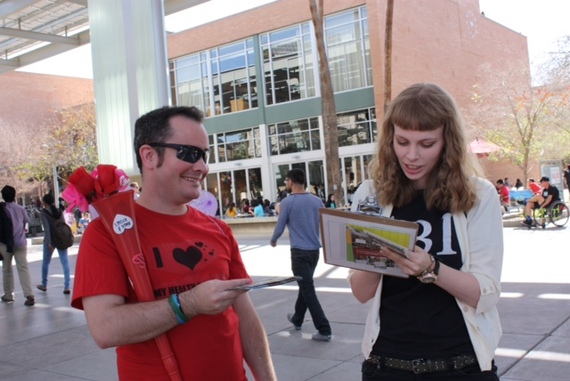As we enter the final few weeks of the first open enrollment period under the Affordable Care Act, Enroll America offices across the country are buzzing with activity and anticipation. While we're thrilled that millions of Americans have already found affordable health insurance through the new Marketplaces and Medicaid, we know our work is far from over. Every one of our staff members and volunteers will be working right through the March 31 deadline to reach those people who face the single greatest barrier to enrollment: lack of knowledge about the new options and the financial assistance that is available for the first time.
To be able to do our job well, our first task is to find those Americans who can benefit from these new health care options. As The New York Times laid out in an article this week that focused on canvassers in Florida, that is no easy task. As we know, the vast majority (82 percent) of people already have health insurance, so finding the uninsured is akin to looking for needles in a haystack. Add to that the fact that 21 states have not expanded Medicaid programs leaving millions unable to find affordable coverage, and those needles become even fewer and farther in between. Add to that, people who are uninsured are fundamentally more difficult to reach since they are much more likely to be unemployed and therefore more transient. The challenge is very similar to the challenges faced by those of us who have worked in the past on electoral campaigns, voter registration drives, enrollment efforts, and private sector marketing. But for uninsured families, the stakes couldn't be any higher or more personal.
So why am I so optimistic heading into the home stretch?
First, because we have built an entire department that utilizes cutting-edge data-modelling techniques to help us find the consumers who are most likely to be uninsured. One in six people in the country are uninsured, but because of our data tools, every third person who answers the door when one of our volunteers knocks turns out to be uninsured. That's a massive improvement in efficiency, and essentially doubles the number of consumers we will be able to reach. Even though these individuals are really hard to find, we'll still be able to reach double the number of uninsured Americans who stand to benefit. That's a success rate any campaign or company would be happy to boast about.
The second reason I'm optimistic is because our outreach and education campaign is much, much more than just a traditional door-to-door canvass transplanted unchanged from campaigns and voter-registration drives. We're constantly collecting and analyzing our data so that we can make continual improvements to our program, and door-to-door canvasses are now just one aspect of our all-of-the-above approach to reaching consumers. For example, we've been able to significantly increase the click-through rate on our digital ads by optimizing our targeting, and we've increased the quality of the conversations we're having by refocusing our canvass and call scripts on the messages we know from our research will be most effective for uninsured consumers.
Perhaps most significantly, we've added new and highly effective ways for volunteers to reach out to people in their neighborhood with information about getting covered. Based on the results we've seen, our volunteers do not use door-to-door canvassing exclusively; they also set up at high-traffic locations like grocery stores or health clinics to share information, and help to host mass enrollment events where consumers can meet with navigators who can walk them through the enrollment process. Our data tells us which precincts have the highest concentrations of uninsured consumers. Our organizers and volunteers in those communities are then engaging local pastors to introduce them to their congregations on Sunday; they are hosting enrollment events at a computer labs on campuses at community colleges; they are working with beauty salon and restaurant owners to educate their staff and customers about these new options.
Each of these changes has significantly increased our ability to reach uninsured consumers, and our staff of 259 and our nearly 19,000 volunteers have now reached out directly to more than 630,000 individual consumers with information about their new health insurance options. That's not counting the more than one million consumers who have visited our website, or the millions more who have seen the #GetCovered hashtag or one of our television, radio, or print ads placed by the Ad Council.
None of us signed up for this job because we thought it was going to be easy -- far from it. We have plenty of obstacles still in our way. But given these challenges, we have the best tools and the best team to get the job done. We know that because we see the results every day. And we know what's at stake for American families because we hear their stories every day. Armed with the data and best practices we've learned over the last few months, we're ready to push even harder in March to make sure as many Americans as possible can find the peace-of-mind that comes with quality, affordable health insurance.

